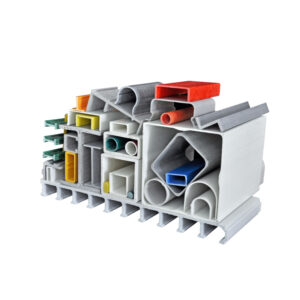FRP pultruded profiles are generally made of polyester resin, surface mat, continuous mat and glass fiber, etc., which are cured at high temperature through a pultrusion process with constant cross-section structural profiles.

There are many types of FRP pultruded profiles, such as FRP pultruded round tubes, FRP pultruded square tubes, FRP pultruded rectangular tubes, FRP pultruded round bars, FRP pultruded I-beams.
The pultrusion process is a special process in the FRP forming process. It is suitable for the production of FRP pultruded profiles with various cross-sectional shapes. It is to impregnate untwisted glass fiber roving and other continuous reinforcement materials with resin, and then maintain a certain It is a composite material production process of forming a pultrusion product by forming a molding die with a cross-sectional shape and making it solidify in the die and then continuously exit the die
The glass fiber reinforced plastic square tube or round tube is selected for the basic frame structure of the fiberglass guardrail, and the fiberglass grating is used as the protective surface, and then the parts are connected together with special connectors. The product is made of glass fiber reinforced plastic, and its molding process is to squeeze the continuous reinforcement material impregnated with resin glue under the action of traction through the molding die, and heat and solidify it in the die and heating system. The product has a variety of colors to choose from, and its own weight is relatively light, whether it is cutting or installation is also very convenient. Moreover, the FRP guardrail is strong, and it is difficult to be deformed or damaged even if it is subjected to a strong impact. The comprehensive performance is good and it has good economic benefits.





























